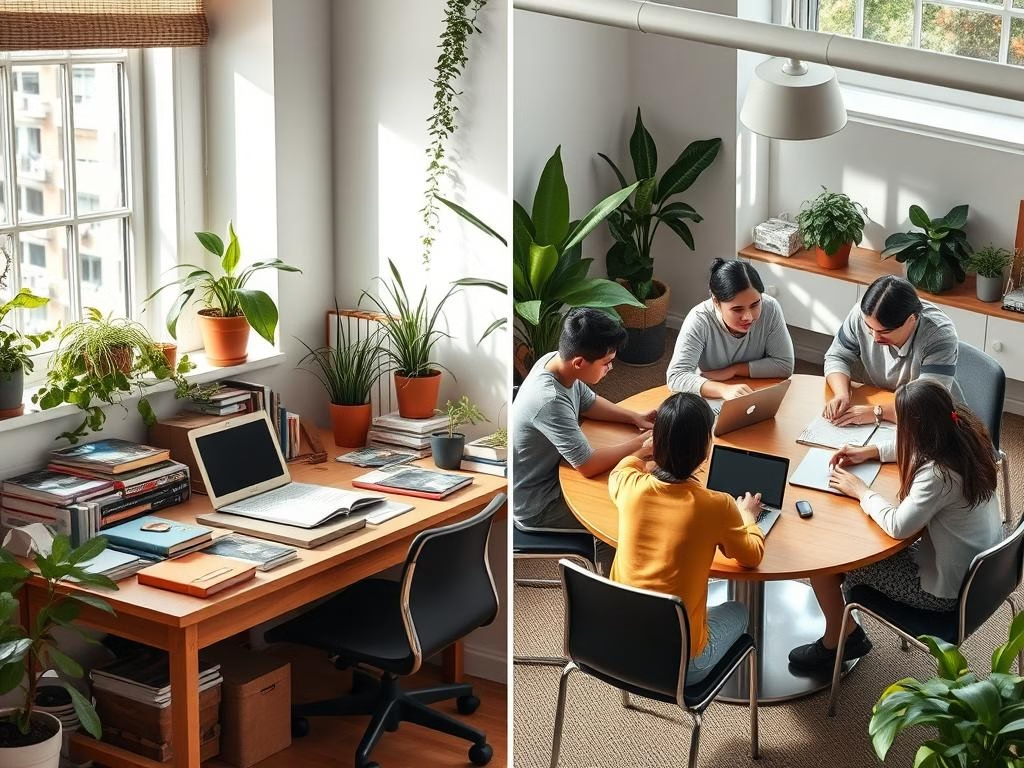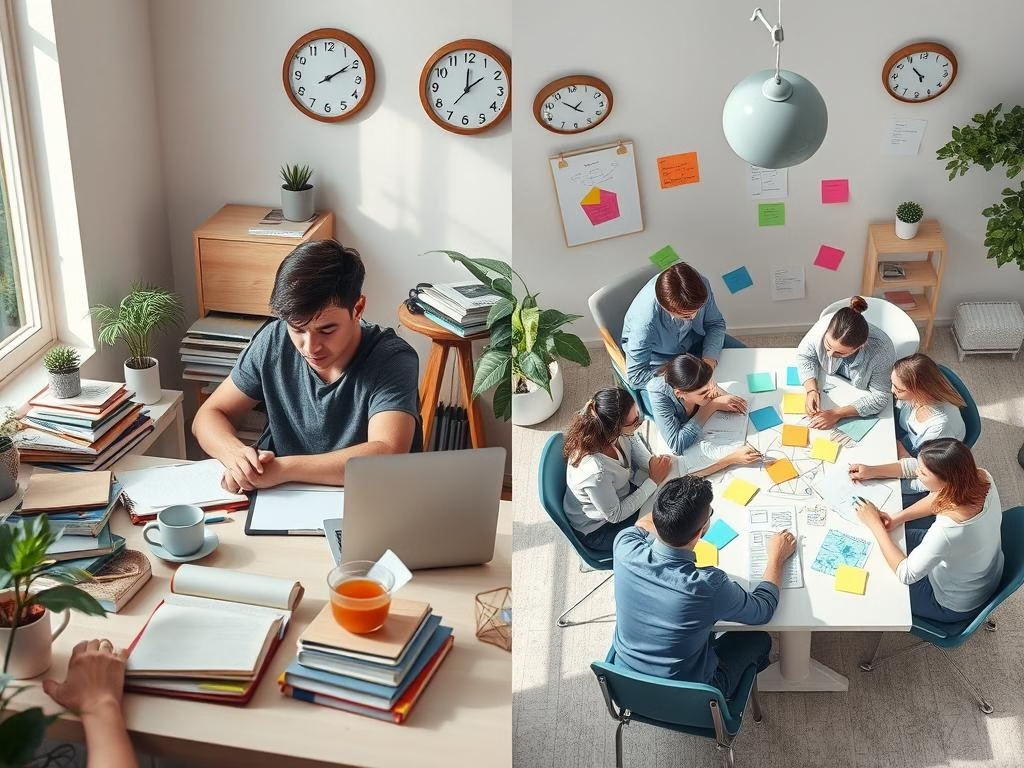Did you know 85% of students find it hard to remember things when studying alone? But, working together can make a big difference, increasing retention by up to 50%. This shows how important it is to mix individual and group learning.
Students need to find the right balance between studying alone and with others. Everyone learns differently, and finding the best way to study is key. It’s about creating an environment that helps you learn and understand better.
It’s clear that one way of studying doesn’t fit all. Students must be flexible and adjust their study methods to fit different subjects and learning styles. Knowing when to work alone and when to team up is essential.
Working in groups has its perks, with 80% of students saying they study harder when with friends. Group work allows for sharing ideas, support, and different views. This is something you can’t get from studying alone.
Studies show that a balanced study approach can really help. Students who mix individual and group study see a 25% boost in organisation and a 40% drop in stress. The aim is to use the best of both worlds, not to pick just one.
As we look into making study better, we’ll share tips for a customised learning plan. It’s all about understanding how to balance individual effort with teamwork. This is the path to doing well in school.
Understanding the Impact of Different Study Methods
Learning is a complex process that needs strategic approaches to retain and understand information. Students aiming to improve their study habits must grasp the different learning techniques.
Research shows key insights into study methods that can greatly enhance learning outcomes. Students often find traditional study methods hard, mainly when moving to more challenging academic settings.
The Science Behind Information Retention
Neuroscientific research points out several important principles for effective learning:
- Practice testing boosts memory recall
- Distributed practice helps retain information longer
- Short, focused study sessions work better than long ones
Psychological Aspects of Learning
Study group dynamics are vital in understanding psychological learning. Students show better engagement in interactive learning settings. These settings encourage:
- Active participation
- Collaborative problem-solving
- Sharing knowledge
Current Research and Statistics
Recent studies offer strong evidence on learning techniques:
| Study Method | Effectiveness Rating |
|---|---|
| Practice Testing | High Utility |
| Distributed Practice | High Utility |
| Highlighting | Low Utility |
By knowing these research-backed strategies, students can adopt more advanced learning methods. These methods go beyond traditional study methods.
How to Balance Individual and Group Study Effectively

Learning how to mix individual and group study is key. It’s all about finding what works best for you. Your study style, the subject, and your goals all play a part.
Here are some tips to balance your study time:
- Know your learning style by thinking about it
- Make a study plan that includes both solo and group work
- Set aside time for each type of study
- Choose study methods that fit the subject
Studies show that setting goals is important. 75% of students say it boosts their grades. A good study plan helps you reach your full learning ability.
Here are some practical tips for balancing study:
- Find subjects that are better learned alone
- Choose topics that are good for group work
- Have clear goals for each study session
- Keep checking and changing your study plan as needed
Research shows that 60% of university students like group study. It’s vital to know your strengths and how you work with others. This way, you can tailor your study plan to get the best results.
Creating an Optimal Individual Study Environment
Creating a good study environment is key for success. The right place can really help you learn better and work faster.
Designing Your Perfect Study Space
Studies show 65% of students like quiet, distraction-free spots for learning best. Think about these things when setting up your study area:
- Find a quiet spot with little noise
- Make sure it’s well-lit and comfy
- Keep it tidy and organised
- Stay away from busy areas
Managing Environmental Distractions
Good study habits mean managing distractions well. About 40% of students find digital distractions hard to handle. Here’s how to stay focused:
- Switch off phone alerts
- Use blockers for websites during study
- Let family or roommates know you’re studying
- Wear noise-cancelling headphones if needed
Essential Tools for Individual Study
Get the right tools to help you learn. Digital tools are great, with 60% of students using apps to plan their study time.
| Study Tool | Purpose | Effectiveness |
|---|---|---|
| Digital Planner | Schedule Management | 68% Productivity Improvement |
| Noise-Cancelling Headphones | Concentration Enhancement | 55% Focus Increase |
| Digital Note-Taking App | Information Organisation | 45% Better Retention |
Pro tip: Spend 10 minutes each day planning and prioritising your study tasks to work more efficiently.
Maximising the Benefits of Solo Study Sessions

Learning alone can change how we study. Solo study lets us focus on what we need to learn. It helps us improve our grades.
Here are some ways to make solo study better:
- Break study time into smaller parts
- Try the Pomodoro Technique for better focus
- Make a study area free from distractions
- Use active learning methods
Studies show 78% of students do better with solo study. The Pomodoro Technique boosts focus and stops burnout.
Here are some tips to improve your study habits:
- Set clear study goals
- Use apps to block distractions
- Plan out your study schedule
- Test yourself and summarise what you’ve learned
Students who study alone in a smart way can see a 15% boost in grades. Knowing how you learn best and tailoring your study can make solo study very effective.
Leveraging Group Study Dynamics
Collaborative learning changes how we study. It makes learning better by sharing experiences. Study groups help students do well and understand more.
Good group study needs planning and talking. Students can learn more by using strategies that make everyone involved.
Establishing Effective Group Guidelines
Good group rules make studying together easy. Important parts include:
- Clear communication rules
- Respect for everyone
- Clear goals for the group
- Ways to keep everyone on track
Role Distribution in Study Groups
Assigning roles helps groups work better. Here are some roles to consider:
- Facilitator: Leads the discussion
- Note-taker: Writes down important points
- Time keeper: Keeps the meeting on schedule
- Research coordinator: Finds extra resources
Managing Group Discussions
Good discussions need a plan. Encourage everyone to speak, respect different views, and keep on topic. Use methods that help everyone think deeply and work together.
By using these strategies, students can make study groups into great learning experiences. This helps them understand and do well in school.
Time Management Strategies for Combined Study Approaches

Learning to manage study time is key. It’s about finding a balance between studying alone and with others. Studies show that good time management can boost productivity by up to 500%. This makes it essential for students to create their own study plans.
Many students find it hard to manage their time, with about 60% struggling with procrastination. To beat these challenges, here are some important strategies:
- Align study sessions with your natural energy rhythms
- Prioritise tasks using urgent and important categorisation
- Implement focused 90-minute study blocks
- Utilise digital planning tools
Digital tools for planning are now used by 70% of students. They help with:
- Tracking study hours
- Setting realistic goals
- Reducing time on non-essential activities
| Time Management Technique | Productivity Impact |
|---|---|
| Task Prioritisation | 40% reduction in non-essential tasks |
| Digital Planning Tools | 15% productivity enhancement |
| Breaking Tasks into 90-minute Blocks | Improved focus and energy maintenance |
Pro tip: Front-load complex tasks during your peak energy hours to maximise efficiency and reduce stress levels. By using these tips, students can make their study routine more structured. This way, they can easily mix individual and group study methods.
Technology Integration in Both Study Methods
Digital technology has changed how we learn, making tools for both solo and group study. Students now have access to new resources that help them study better and work together more effectively.
Today’s educational tech offers flexible solutions for all kinds of learners. Students can use digital platforms to make their study sessions personal and work together easily, no matter where they are.
Digital Tools for Individual Study
- Note-taking apps that sync to the cloud
- Custom flashcard programs
- Software for managing time
- Interactive learning apps
Collaborative Learning Platforms
Virtual study spaces let students connect and learn together, no matter where they are. Tools like Google Docs and Collabrify Suite make it easy to work together and get feedback in real-time.
| Platform | Key Features | Study Benefits |
|---|---|---|
| Google Docs | Real-time editing | Collaborative writing |
| Kahoot | Interactive quizzes | Engagement boost |
| Blackboard | Assignment management | Organisational support |
Virtual Study Group Solutions
New tech is making it easier to switch between solo and group study. Video conferencing tools, shared digital spaces, and interactive platforms offer new ways to learn together.
By using these tech tools, students can create more dynamic, engaging, and effective study plans that fit their unique learning styles.
Overcoming Common Challenges in Mixed Study Approaches
It’s tough to balance studying alone and with others. Students face many hurdles that can stop them from learning. Knowing these problems is the first step to a better study space.
The biggest issues often include:
- Unequal participation among group members
- Conflicting learning paces
- Scheduling complications
- Motivational disparities
To beat these problems, students need smart ways to work together and stay focused on their own goals.
| Challenge | Potential Solution |
|---|---|
| Unequal Contribution | Establish clear role assignments and expectations |
| Different Learning Styles | Create flexible study methods that accommodate diverse approaches |
| Time Management Conflicts | Develop structured schedules with built-in individual study time |
Effective communication is key to success in mixed study methods. Students should talk about their needs, goals, and challenges often. This keeps the study group united and supportive.
Using a rotating leader in study groups helps share tasks and keeps everyone involved. This way, everyone gets to learn both together and alone.
Measuring Progress and Adjusting Study Methods
Improving study habits needs a smart plan to track and tweak your learning ways. Making a personal study plan is key to doing well in school. Studies show that students who check their study methods often do much better.
There are several ways to track your progress:
- Implement regular self-assessment techniques
- Collect feedback from peers and teachers
- Use numbers to measure how well you’re doing
Studies say that students who track their progress well can see a 50% boost in their grades. Important numbers to look at include:
| Progress Measurement Method | Potential Performance Improvement |
|---|---|
| Time log tracking | 20% increase in effective planning |
| Task completion rate | 60% improvement in goal achievement |
| Mobile app reminders | 40% better schedule adherence |
Learning needs to be flexible and always changing. Students should be ready to change their study ways based on what works best for them.
Here are some tips to improve your study habits:
- Break big tasks into smaller, easier steps
- Use the Pomodoro technique for focused study
- Try active recall methods
- Keep a study schedule that’s both structured and flexible
By using data to guide your study plan, you can keep improving your learning methods. This will help you get even better grades.
Building Long-term Study Habits and Routines
Creating lasting study habits is key to success in school. Good study techniques need careful planning and a steady effort. Students often find it hard to stay motivated and keep up with changing school needs.
To build lasting study habits, know your learning style and make flexible plans. Tailor your study habits to fit your academic path. This way, you can learn more effectively.
Creating Sustainable Study Schedules
Research shows the value of having a structured study plan. Here are some tips for making a good study schedule:
- Follow the 52/17 rule for work and breaks
- Use spaced repetition to remember things
- Set realistic learning goals
- Try active learning methods
Adapting to Different Learning Phases
Being flexible is key in study habits. Each stage of learning needs a different approach.
| Learning Phase | Recommended Strategy | Focus Area |
|---|---|---|
| Initial Learning | Exploratory techniques | Broad understanding |
| Exam Preparation | Intensive revision | Detailed knowledge consolidation |
| Project Work | Collaborative learning | Practical application |
Maintaining Motivation
Keeping motivated for long-term study needs smart strategies. Psychological research suggests that setting goals and rewarding yourself can help a lot.
- Break big goals into smaller tasks
- Regularly check your progress
- Enjoy small wins
- Get support from friends
By using these tips, students can build strong study habits. Remember, good study habits are about being consistent and flexible.
Conclusion
Learning to balance individual and group study is a key skill that boosts your grades. Research shows that different study methods work for different people. By finding what works best for you, you can improve your learning.
Flexible study plans are important. Mixing solo and group study can raise your grades by 15%. This way, you get the best of both worlds. Group study helps you understand concepts better, while solo time is vital for deep learning.
Universities now offer various study spaces, like the University of Edinburgh’s Main Library. These places help you focus or work together. The National Careers Service says learning to adapt your study skills is key for future jobs.
Finding the right study method is all about you. Try different ways, stay open to new ideas, and keep improving. Using both individual and group study helps you build a strong learning plan. This will help you succeed in your studies.




